Welcoming a dog into your home brings immense joy and companionship, but for many, the concern of allergies can be a significant barrier. Dog allergies, primarily triggered by dander (flakes of dead skin), saliva, and urine, can cause uncomfortable symptoms like sneezing, itching, and wheezing. This is where the concept of “hypoallergenic dogs” or, more accurately, types of dogs who don’t shed much, becomes incredibly appealing.
While no dog is truly 100% allergen-free, certain breeds produce significantly less dander and shed minimally, making them a much better fit for individuals with sensitivities. These breeds are often sought after for their low-shedding coats, which can help reduce the spread of allergens in the home. If you’re an allergy sufferer dreaming of canine companionship, understanding which breeds fall into this category is the first step toward finding your perfect furry friend.
In this comprehensive guide, we’ll delve into what truly makes a dog “hypoallergenic,” explore a diverse list of dog breeds that don’t shed (or shed very little), and provide essential tips for living harmoniously with your low-shedding companion. Discover the ideal breed that allows you to experience the unconditional love of a dog without the constant worry of allergic reactions. For more details on specific sizes, you can explore types of small dogs that dont shed that might be a perfect fit for apartment living or families seeking a compact companion.
Understanding “Hypoallergenic”: What Does It Really Mean?
The term “hypoallergenic” often leads to a common misconception that these dogs are completely free of allergens. However, this isn’t entirely accurate. All dogs produce allergens, which are proteins found in their skin, saliva, and urine. The primary allergen often associated with dog allergies is Can f 1, found in dander, which consists of microscopic flakes of skin shed by the dog.
What truly differentiates “hypoallergenic” breeds, or more appropriately, types of dogs who don’t shed frequently, is their tendency to produce less dander and/or shed significantly less hair. Less shedding means fewer allergen-laden hairs are released into the environment, which can then collect on furniture, carpets, and air filters. Curly or wiry coats, common among many low-shedding breeds, also tend to trap dander and loose hairs, preventing them from becoming airborne.
It’s crucial to remember that even a low-shedding dog still contains allergens in their skin, saliva, and urine. For severe allergy sufferers, even minimal exposure can trigger a reaction. Therefore, managing allergies requires a holistic approach that includes careful breed selection, consistent grooming, and maintaining a clean home environment. Understanding these nuances helps set realistic expectations for pet ownership for those with allergies.
25+ Popular Dog Breeds Who Don’t Shed (or Shed Minimally)
If you’re looking for a companion that won’t leave a trail of hair on your furniture and clothes, these breeds are excellent choices. They are often among the most sought-after types of dogs who don’t shed extensively, making them ideal for allergy sufferers.
1. Poodle (Standard, Miniature, Toy)
 A white Standard Poodle, a popular type of dog who doesn't shed, walks gracefully through a grassy park.
A white Standard Poodle, a popular type of dog who doesn't shed, walks gracefully through a grassy park.
Poodles are perhaps the most well-known of the non-shedding breeds, and for good reason. Available in three sizes—Standard, Miniature, and Toy—they all boast a dense, curly coat that sheds minimally and traps dander. Poodles are renowned for their exceptional intelligence, making them highly trainable and versatile companions. Originating as water retrievers, they are active and enjoy engaging in mental and physical challenges. Regular grooming, including brushing and professional clipping every 4-6 weeks, is essential to prevent their curls from matting.
2. Yorkshire Terrier
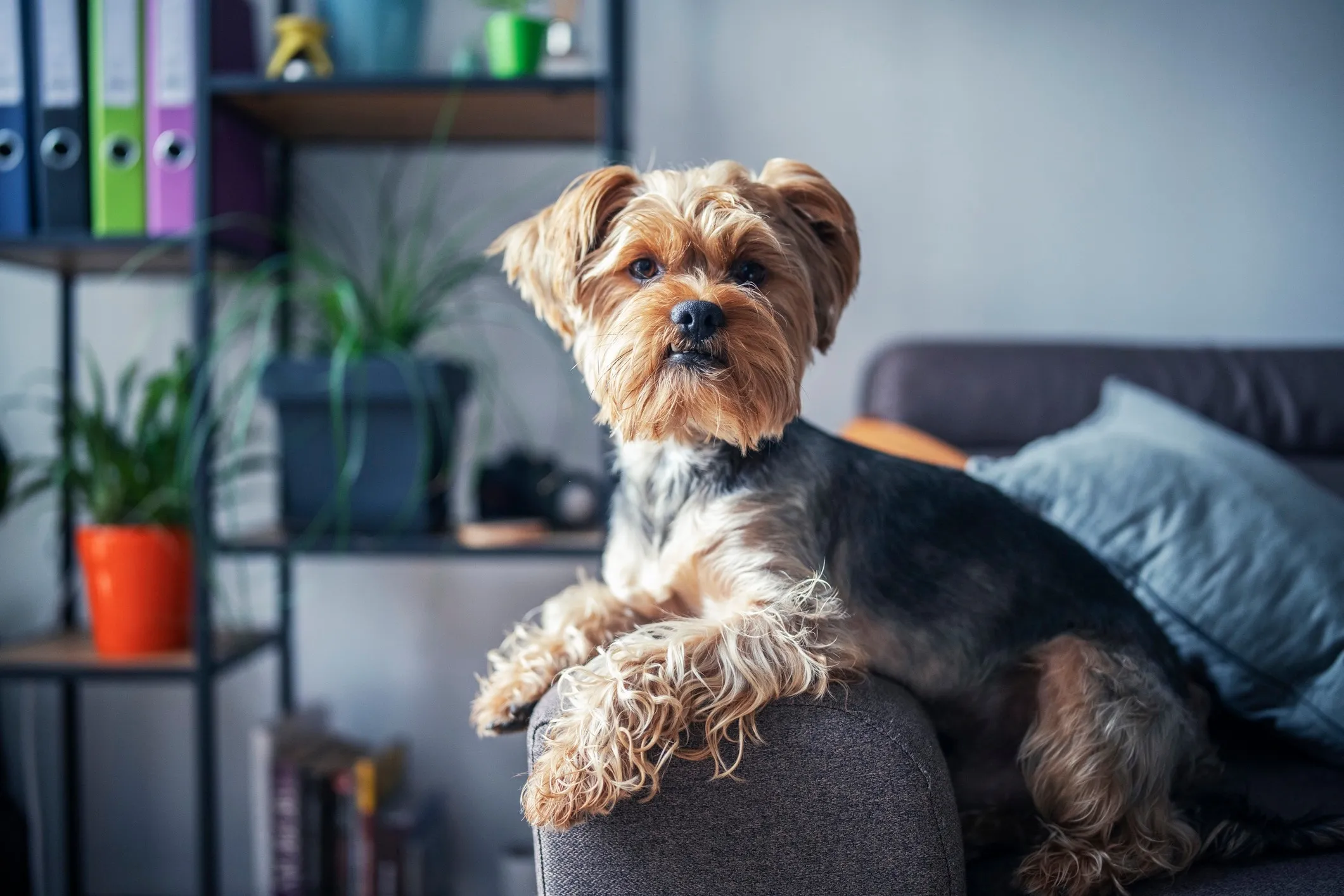 A blue and tan Yorkshire Terrier, an adorable small dog that doesn't shed much, lounges comfortably on an armchair.
A blue and tan Yorkshire Terrier, an adorable small dog that doesn't shed much, lounges comfortably on an armchair.
These spirited little dogs, affectionately known as Yorkies, are a fantastic option for those seeking small types of dogs that don’t shed. Despite their long, silky coats, Yorkshire Terriers shed very little. They possess a big personality in a tiny package, being both spunky and incredibly affectionate. Yorkies adapt well to various living situations, from spacious houses to compact apartments, provided they receive ample attention and playtime from their families. Daily brushing is necessary to keep their fine coats free of tangles and looking their best.
3. Shih Tzu
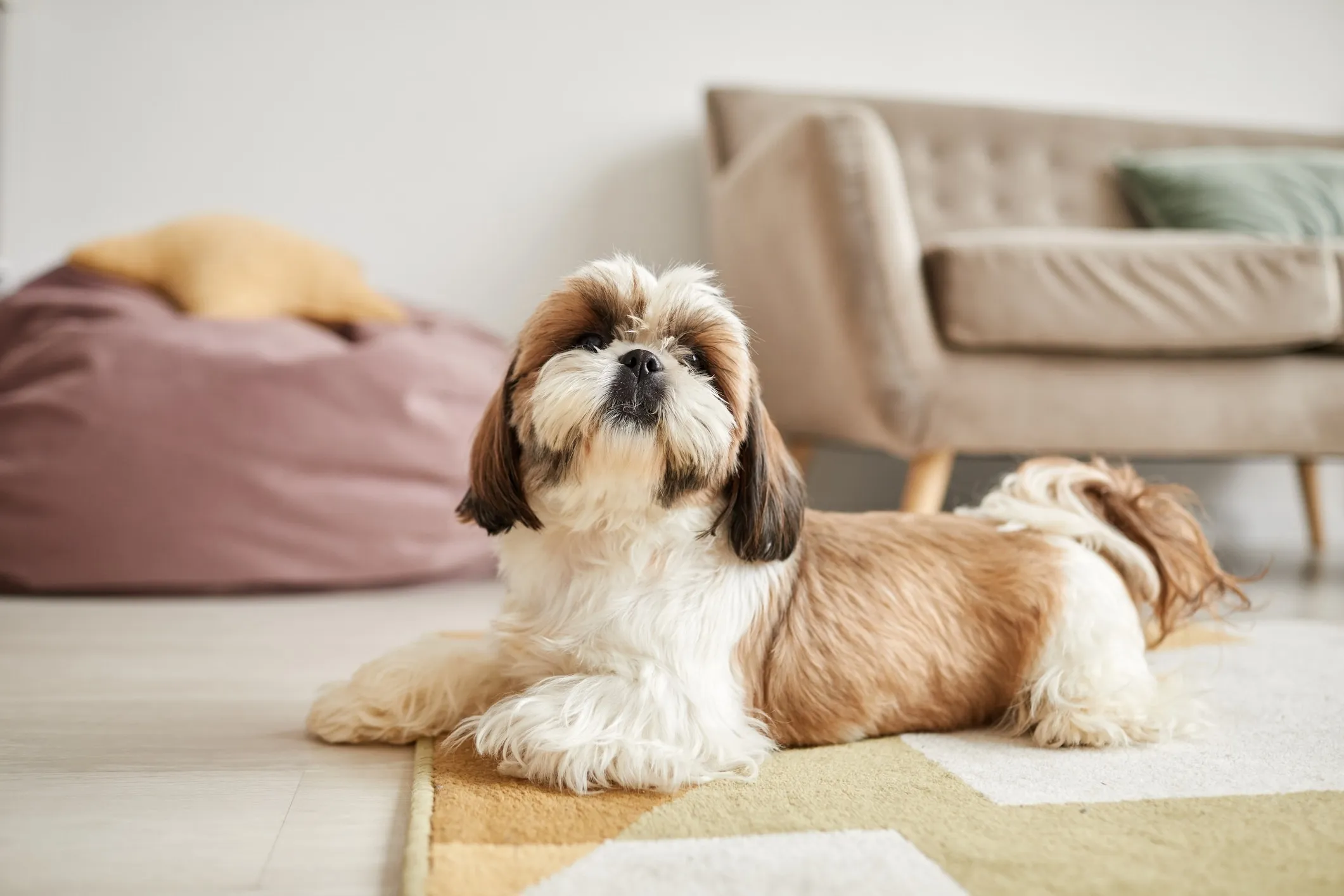 A brown and white Shih Tzu, a friendly small dog breed that doesn't shed excessively, rests calmly on a living room floor.
A brown and white Shih Tzu, a friendly small dog breed that doesn't shed excessively, rests calmly on a living room floor.
The Shih Tzu is an ancient companion breed celebrated for its luxurious, flowing double coat and amiable disposition. Like the Yorkie, this charming breed sheds minimally, making them a popular choice among different types of small dogs that don’t shed. Their friendly and outgoing nature makes them excellent family pets. However, their brachycephalic (flat) face can lead to certain health considerations, such as a susceptibility to overheating and breathing difficulties, as well as tear staining around the eyes. Regular cleaning with eye wipes can help manage tear stains, and consistent grooming is vital to prevent matting of their thick coat.
4. Miniature Schnauzer
 A salt and pepper Miniature Schnauzer, a smart and sturdy dog breed that doesn't shed much, wears a pink harness in a park.
A salt and pepper Miniature Schnauzer, a smart and sturdy dog breed that doesn't shed much, wears a pink harness in a park.
The Miniature Schnauzer is the smallest of the three Schnauzer varieties, standing no more than 14 inches tall and weighing 10-20 pounds. These intelligent and robust dogs have a wiry, low-shedding coat that requires regular hand-stripping or clipping to maintain its texture and minimize shedding. Miniature Schnauzers are adaptable and can thrive in various home environments, provided they receive at least an hour of daily exercise to satisfy their energetic nature.
5. Standard Schnauzer
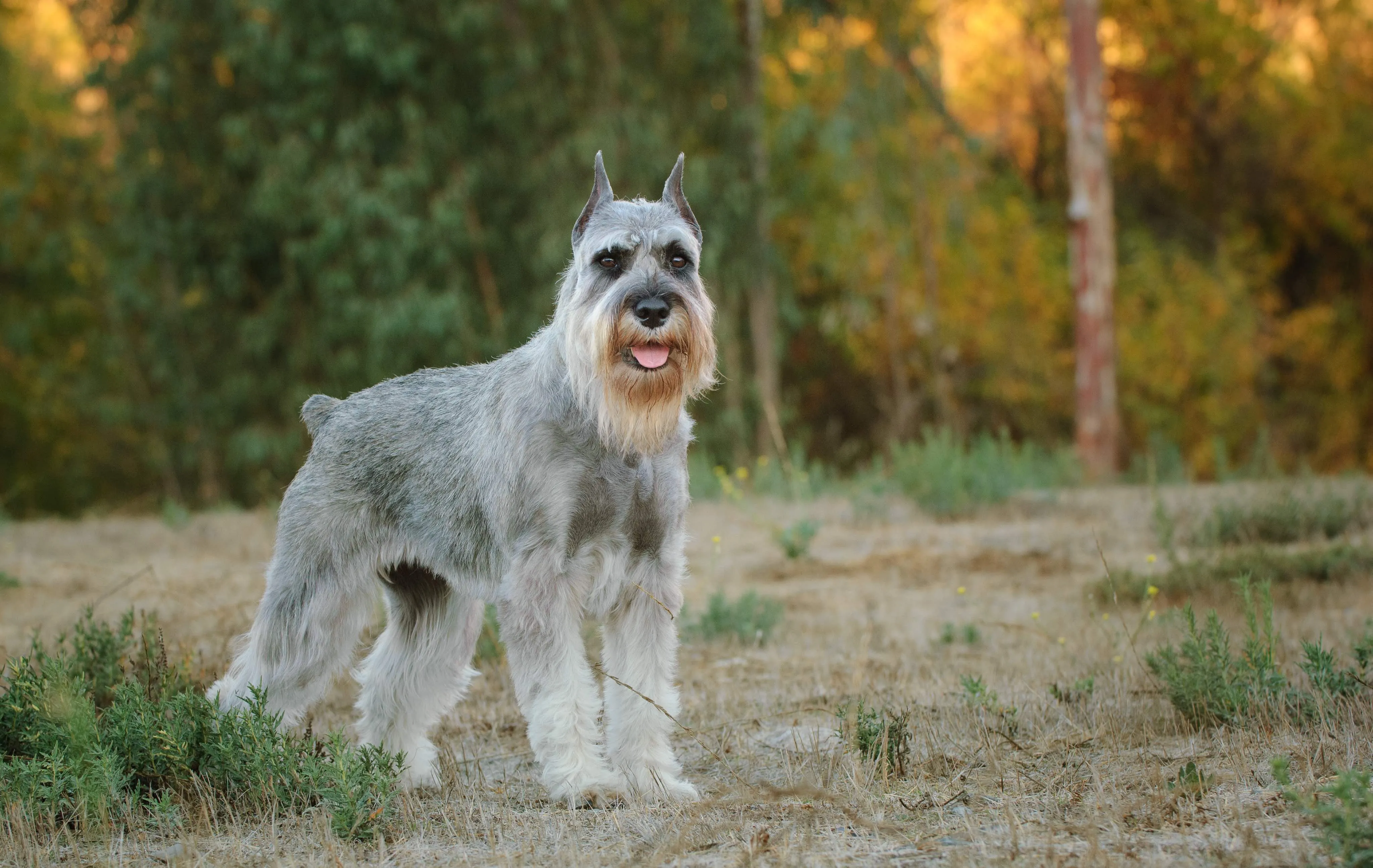 A gray Standard Schnauzer, a medium-sized dog breed that doesn't shed much, stands alert in a field.
A gray Standard Schnauzer, a medium-sized dog breed that doesn't shed much, stands alert in a field.
The Standard Schnauzer shares many admirable qualities with its miniature counterpart but in a larger frame, typically weighing up to 45 pounds. These dogs also have a wiry, low-shedding coat that contributes to their status as a great dog breed that doesn’t shed much. They are highly intelligent, protective, and energetic, thriving on long walks, games of fetch, and mentally stimulating activities like puzzle toys. Their strong bond with family and keen alertness make them excellent watchdogs.
6. Giant Schnauzer
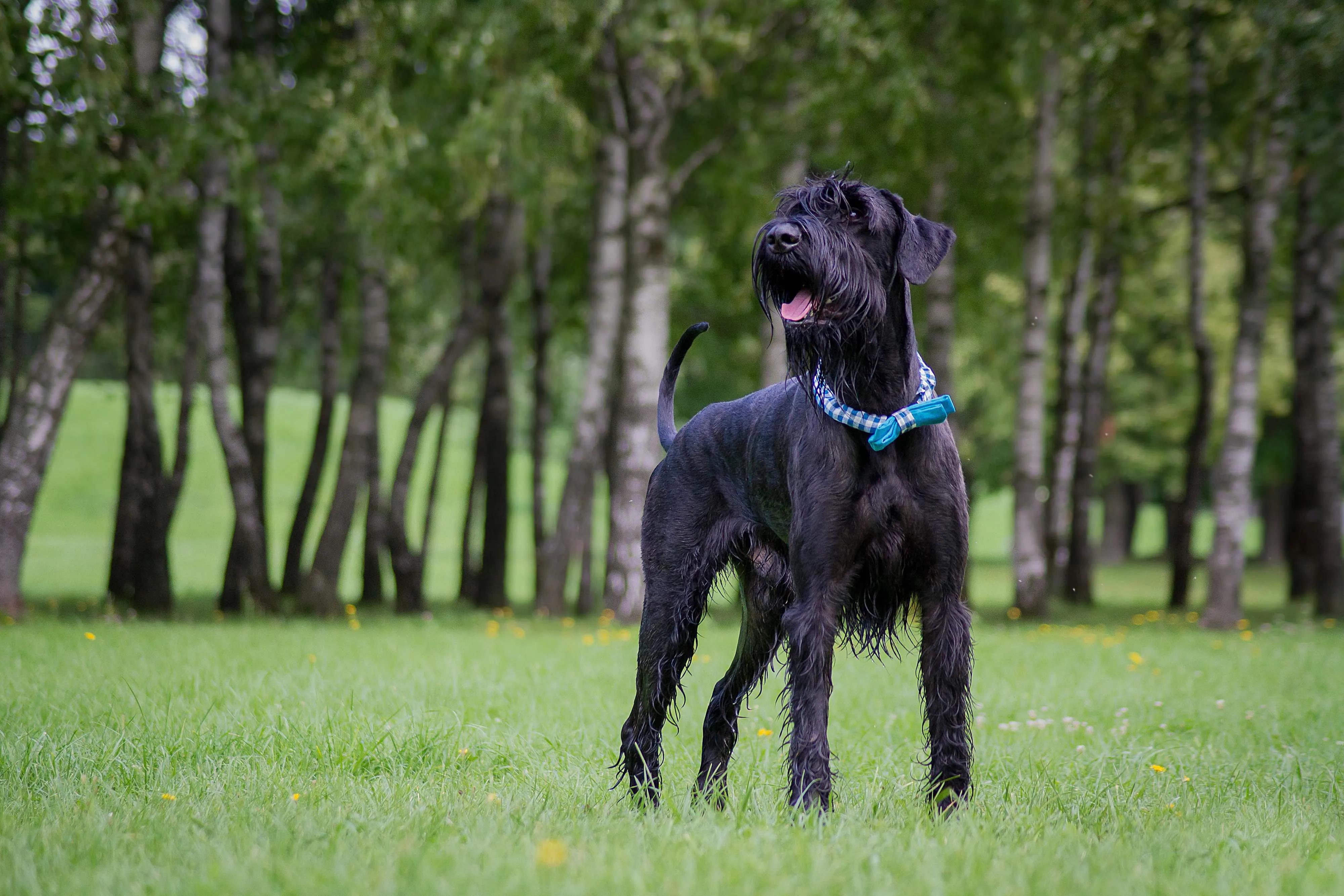 A black, wet Giant Schnauzer, one of the biggest types of dogs who don't shed, wears a blue bow collar while standing in a park.
A black, wet Giant Schnauzer, one of the biggest types of dogs who don't shed, wears a blue bow collar while standing in a park.
As the largest of the Schnauzer family, Giant Schnauzers can stand over 27 inches tall and weigh up to 85 pounds. Despite their imposing size, they are considered hypoallergenic due to their dense, wiry coats that shed minimally. These powerful and intelligent dogs require extensive exercise to keep them happy and well-behaved, including long walks, runs, hikes, and active playtime. Their high energy and need for mental stimulation make them best suited for experienced dog owners who can provide consistent training and engagement.
7. Bichon Frise
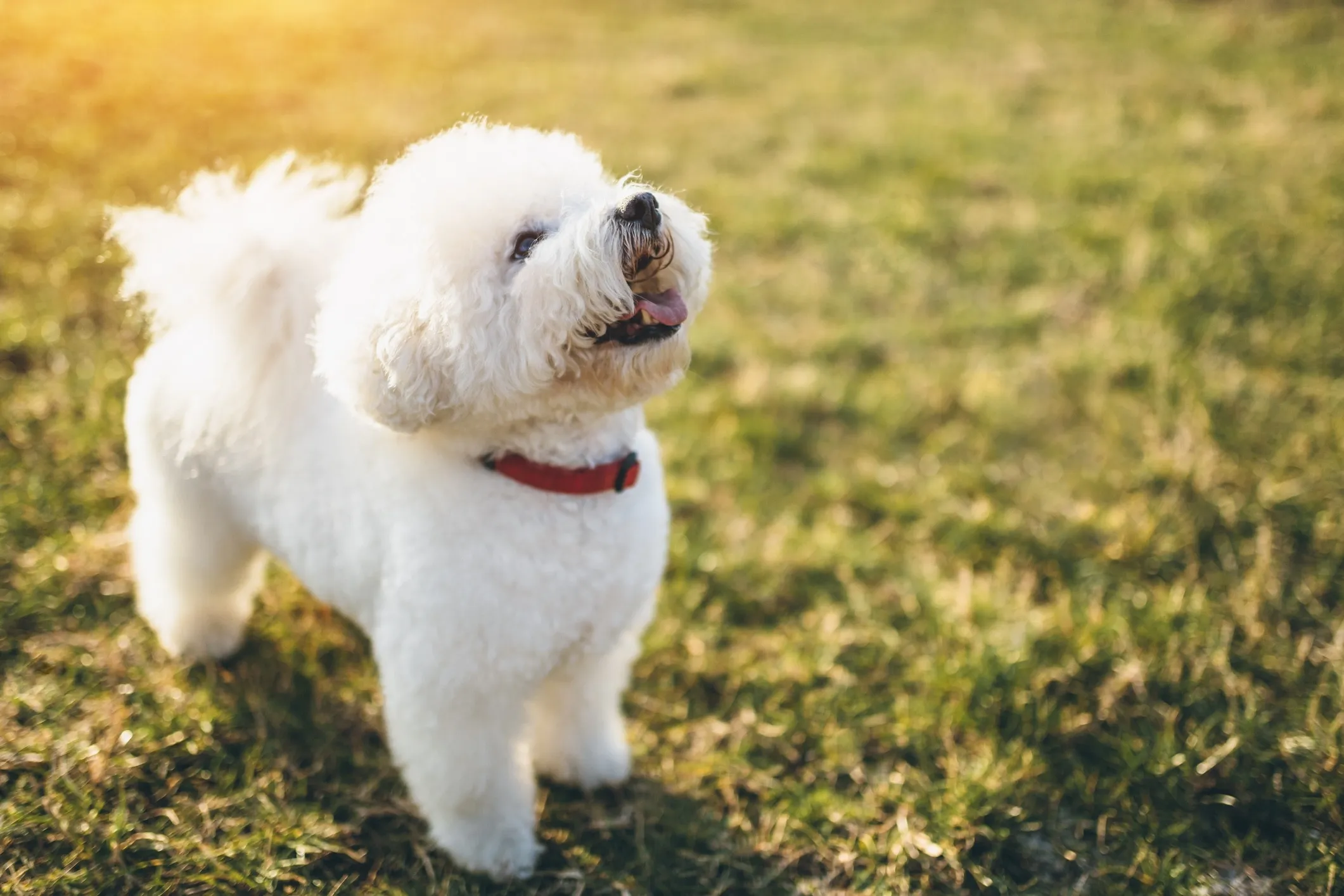 A white Bichon Frise dog, a small, playful type of dog who doesn't shed, looks up attentively in the grass.
A white Bichon Frise dog, a small, playful type of dog who doesn't shed, looks up attentively in the grass.
The Bichon Frise is a delightful small dog known for its playful spirit, affectionate nature, and fluffy, curly white coat that is famously low-shedding. Their cheerful disposition and high intelligence make them highly trainable, quickly mastering basic commands and enjoying learning fun tricks. Bichons thrive on companionship and are generally good with children and other pets, making them a wonderful family addition for those sensitive to dander. Regular grooming is essential to keep their unique coat from matting.
8. Chinese Crested
 A black hairless Chinese Crested dog, a unique type of dog that doesn't shed, looks intently at the camera.
A black hairless Chinese Crested dog, a unique type of dog that doesn't shed, looks intently at the camera.
The Chinese Crested is a truly distinctive breed, coming in two varieties: hairless and powderpuff. The hairless version has smooth, soft skin with tufts of hair on its head, tail, and paws, making it a clear choice for a type of dogs that don’t shed. The powderpuff variety, while covered in long, silky hair, also sheds minimally. Both varieties are affectionate, playful, and make devoted companions. Their unique appearance and gentle nature make them a fascinating and suitable option for many allergy sufferers.
9. Portuguese Water Dog
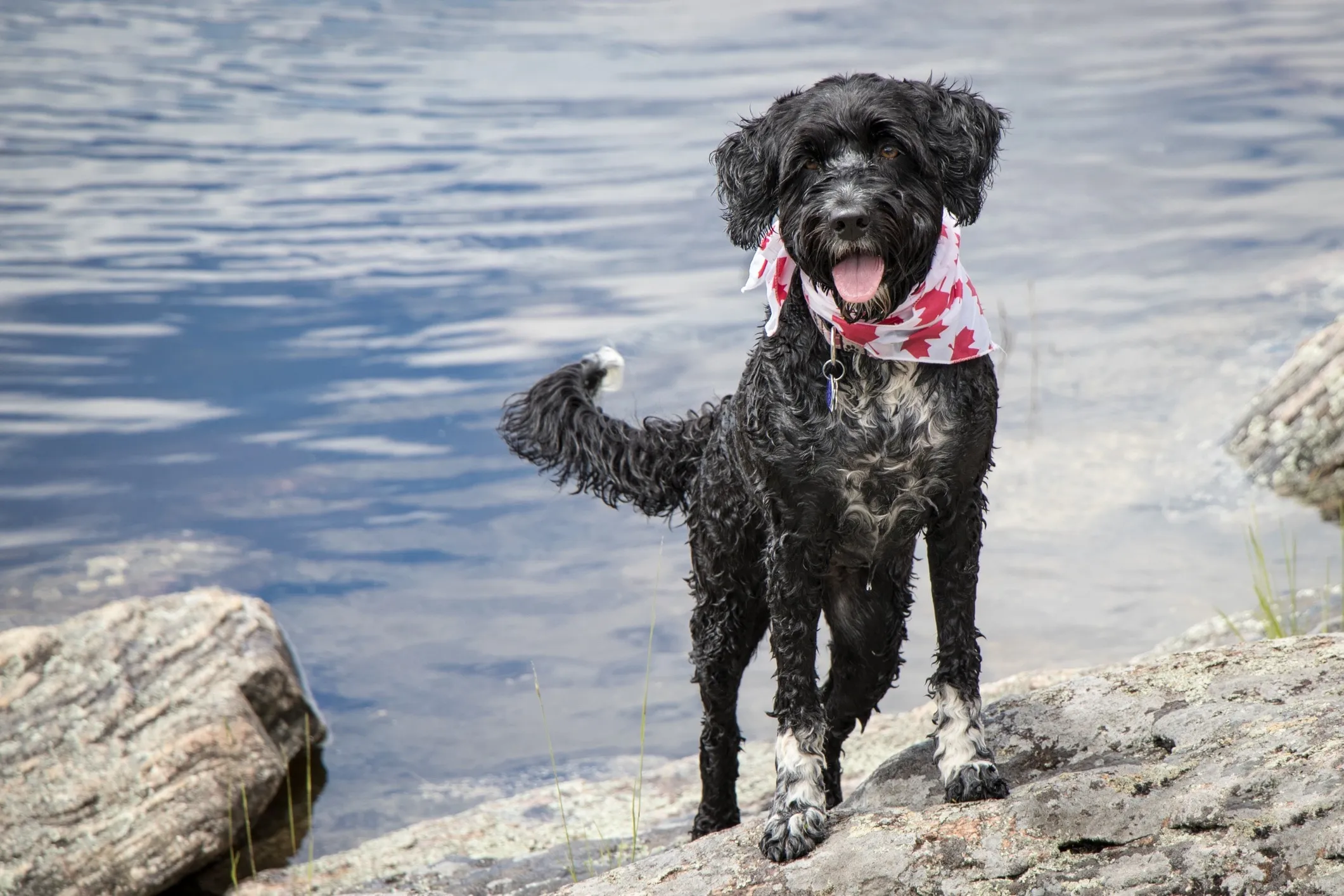 A black and white Portuguese Water Dog, a medium-sized dog breed that doesn't shed much, wears a red maple leaf bandana in front of water.
A black and white Portuguese Water Dog, a medium-sized dog breed that doesn't shed much, wears a red maple leaf bandana in front of water.
Originally bred to assist fishermen in Portugal, the Portuguese Water Dog is a robust, medium-sized breed with a thick, curly coat that sheds very little. This makes them a popular dog breed that doesn’t shed much and is well-suited for active families. They are highly intelligent, easily trainable, and possess a friendly, outgoing temperament. Given their heritage, Portuguese Water Dogs have high energy levels and a natural love for water, thriving on regular, vigorous exercise that includes activities like swimming and fetching floating toys.
10. Labradoodle
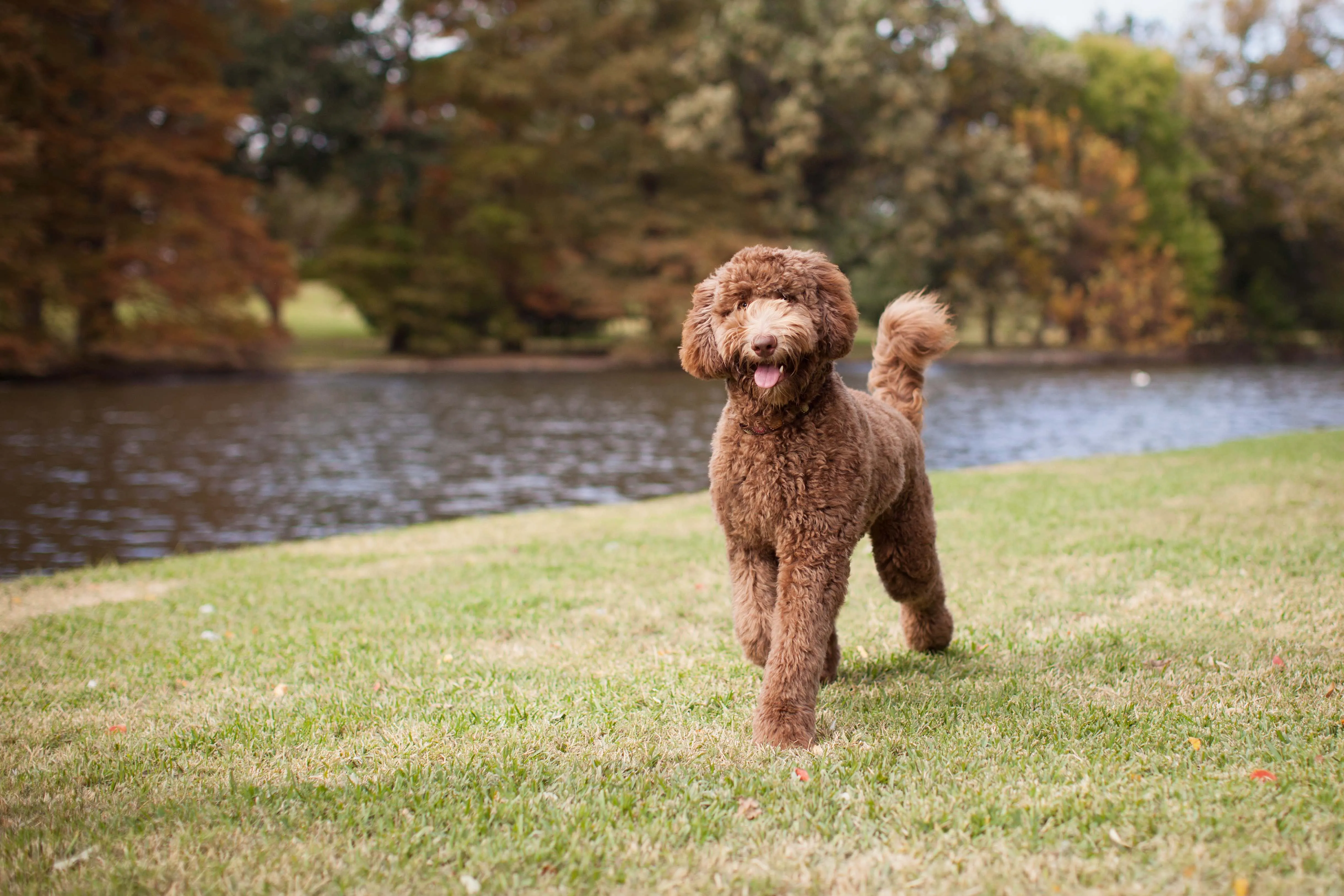 A brown Standard Labradoodle, a friendly crossbreed among types of dogs who don't shed, walks through a park.
A brown Standard Labradoodle, a friendly crossbreed among types of dogs who don't shed, walks through a park.
A crossbreed of a Labrador Retriever and a Poodle, the Labradoodle was initially developed to be a hypoallergenic service dog. This popular hybrid inherits the intelligence of the Poodle and the friendly, eager-to-please nature of the Labrador. Their coats vary but are typically low-shedding, making them excellent family pets for individuals with allergies. Labradoodles are highly trainable, gentle, and thrive when well-exercised and socialized from an early age.
11. Goldendoodle
 A Goldendoodle, a popular doodle dog known for not shedding much, lies on a couch with a person in the background.
A Goldendoodle, a popular doodle dog known for not shedding much, lies on a couch with a person in the background.
Another beloved “doodle” breed, the Goldendoodle is a cross between a Golden Retriever and a Poodle. Like the Labradoodle, they are celebrated for their low-shedding coats, friendly disposition, and high intelligence, embodying the best traits of both parent breeds. While often known for their golden coats, Goldendoodles come in a variety of colors and coat textures. They require frequent grooming with a slicker brush to prevent matting and keep their wavy or curly coats in prime condition.
12. Lagotto Romagnolo
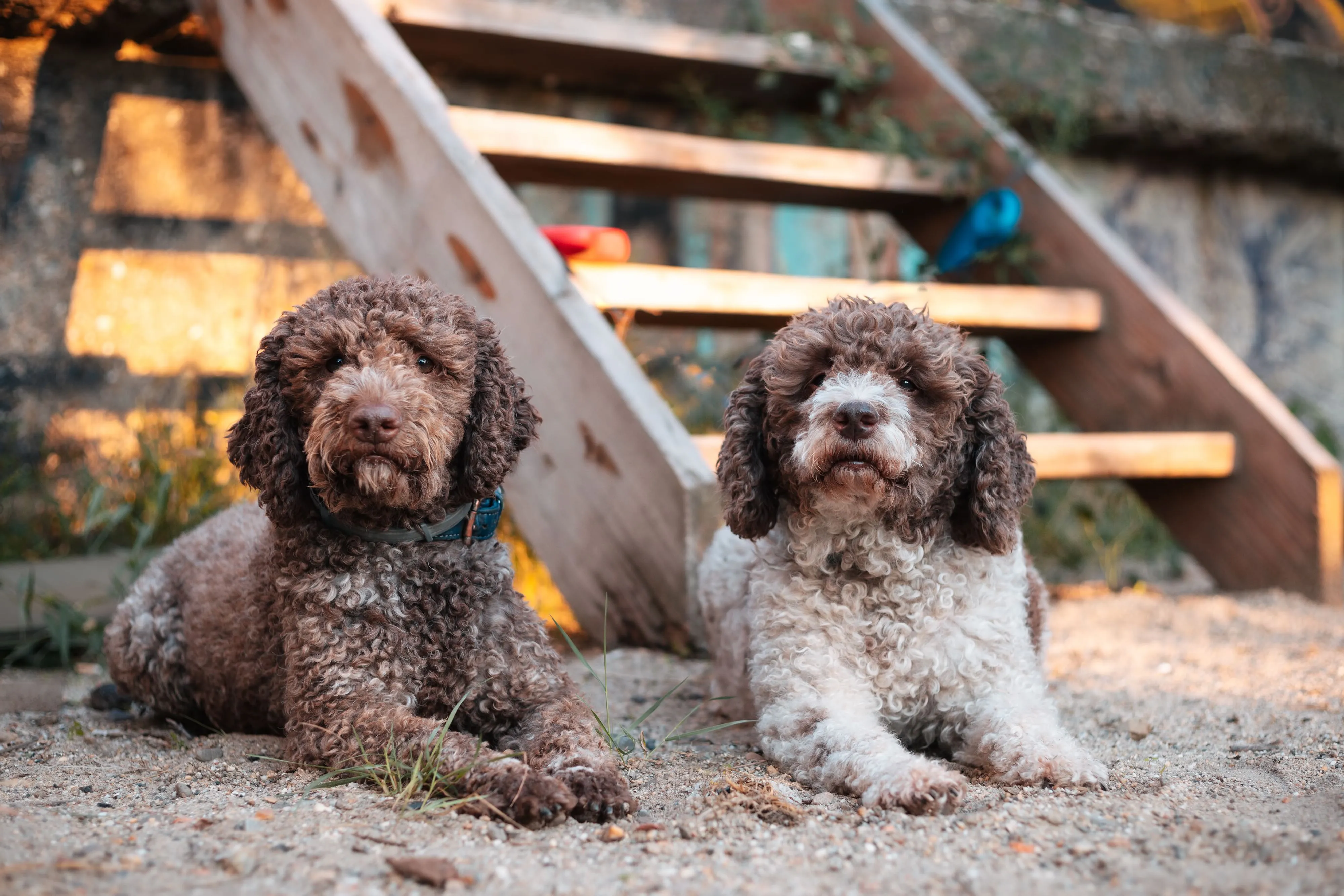 Two Lagotto Romagnolo dogs, known for their woolly coats and being types of dogs who don't shed, lie in dirt staring at the camera.
Two Lagotto Romagnolo dogs, known for their woolly coats and being types of dogs who don't shed, lie in dirt staring at the camera.
Hailing from Italy, the Lagotto Romagnolo was originally bred as a water retriever, and their distinctive curly, woolly coat protected them from cold waters. This coat is also responsible for their low-shedding qualities, making them suitable for allergy sufferers. Though less common than other hypoallergenic breeds, Lagotti Romagnoli (the plural form) are generally good with children and other pets, making them adaptable and loving family dogs who thrive with active engagement.
13. Affenpinscher
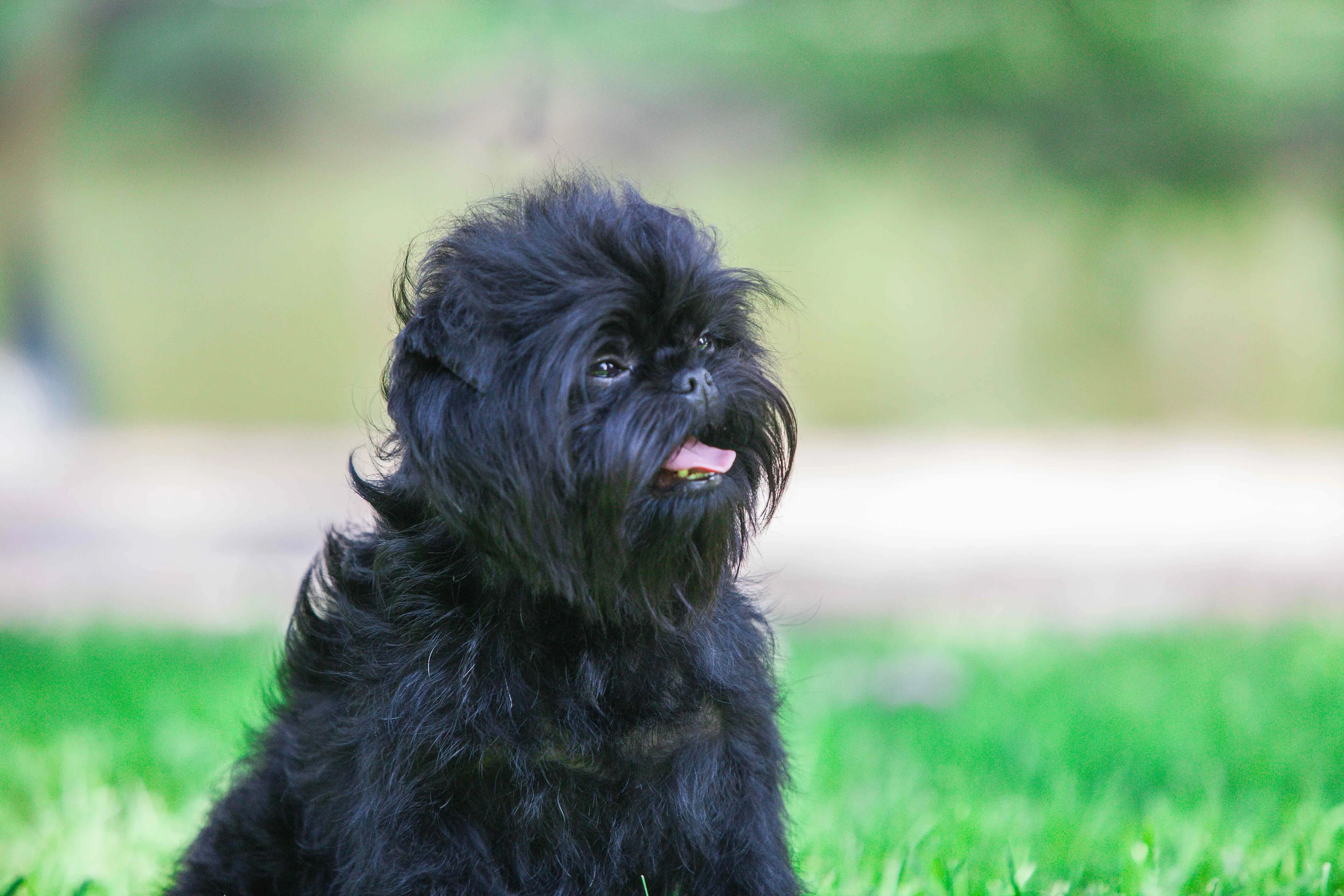 A black Affenpinscher dog, a small type of dog who doesn't shed, captured in a close-up shot.
A black Affenpinscher dog, a small type of dog who doesn't shed, captured in a close-up shot.
Known for their endearing monkey-like expression, Affenpinschers are small, charming dogs with a dense, wiry coat that produces fewer allergens than many other breeds. While low-shedding, their unique coat requires dedicated care, including regular at-home brushing and professional hand-stripping rather than trimming, to maintain its texture and minimize loose hairs. These playful and confident little dogs make engaging companions.
14. Irish Water Spaniel
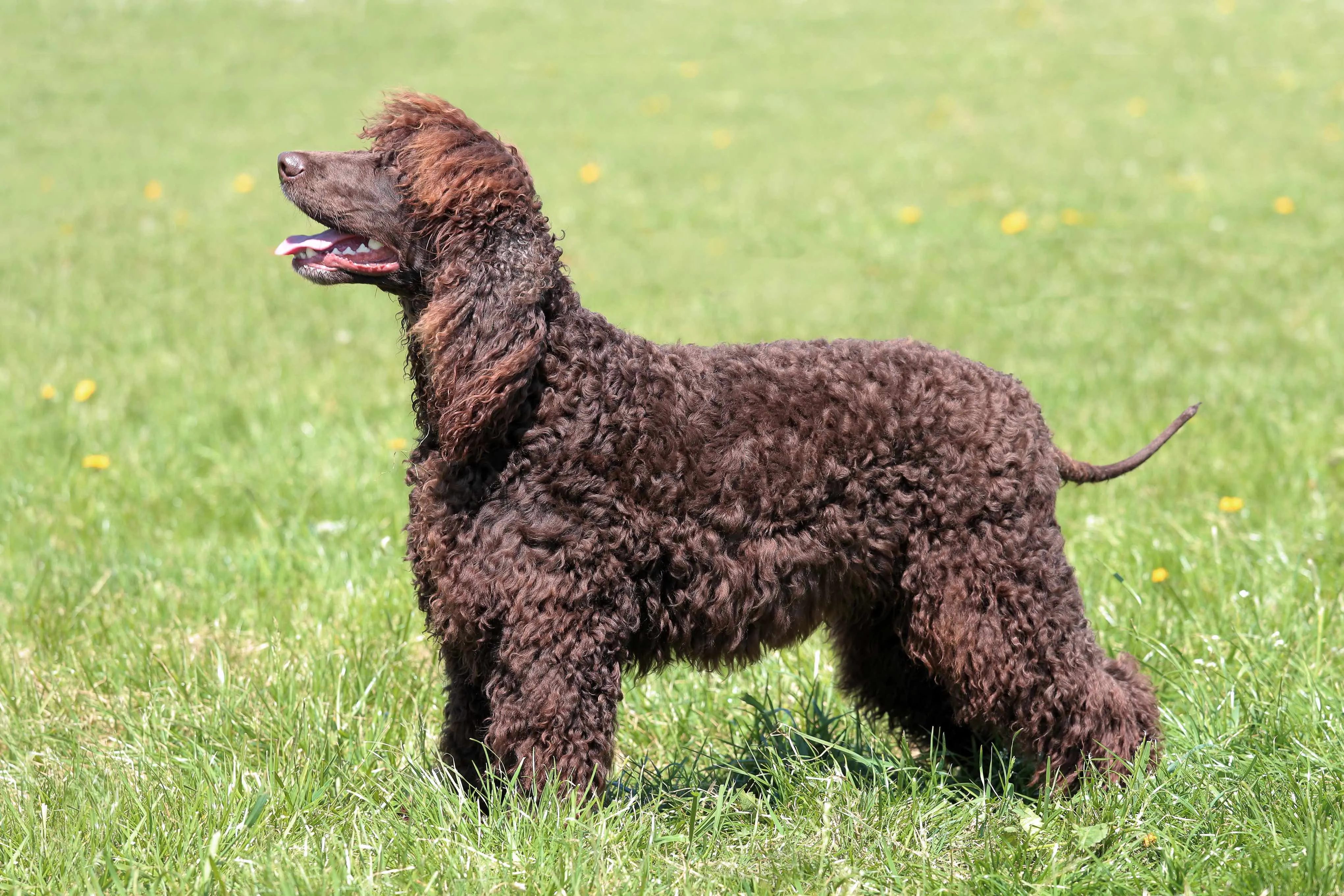 A brown Irish Water Spaniel, an intelligent water dog breed that doesn't shed much, shown in profile.
A brown Irish Water Spaniel, an intelligent water dog breed that doesn't shed much, shown in profile.
Friendly, intelligent, and highly trainable, the Irish Water Spaniel is a distinguished water dog originally bred for retrieving game. Their thick, tightly curled coat is a distinctive liver (brown) color and sheds minimally, placing them among the excellent types of dogs who don’t shed for active individuals. This breed possesses a high energy level and requires ample regular exercise to remain happy and healthy. Consistent grooming is necessary to maintain the condition of their unique coat.
15. Aussiedoodle
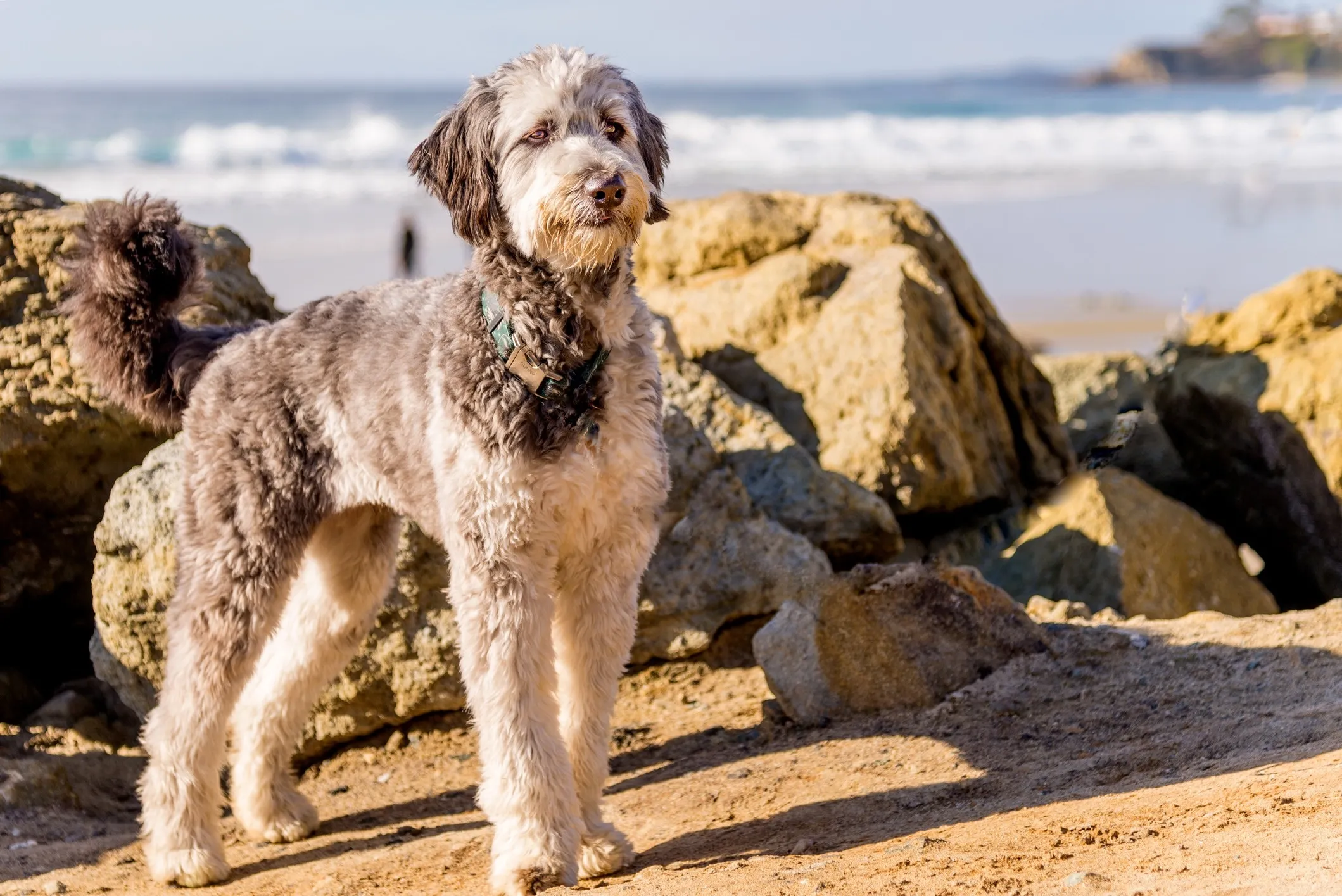 A standard Aussiedoodle dog, a smart and energetic non-shedding crossbreed, stands on a beach.
A standard Aussiedoodle dog, a smart and energetic non-shedding crossbreed, stands on a beach.
The Aussiedoodle is a cross between an Australian Shepherd and a Standard or Miniature Poodle, combining the intelligence and energy of both parent breeds. This low-shedding hybrid is exceptionally smart and active. Without sufficient exercise and mental stimulation through enrichment toys and training, Aussiedoodles can become bored and potentially destructive. They thrive in homes where their high energy can be channeled into positive activities and consistent engagement.
16. Bolognese
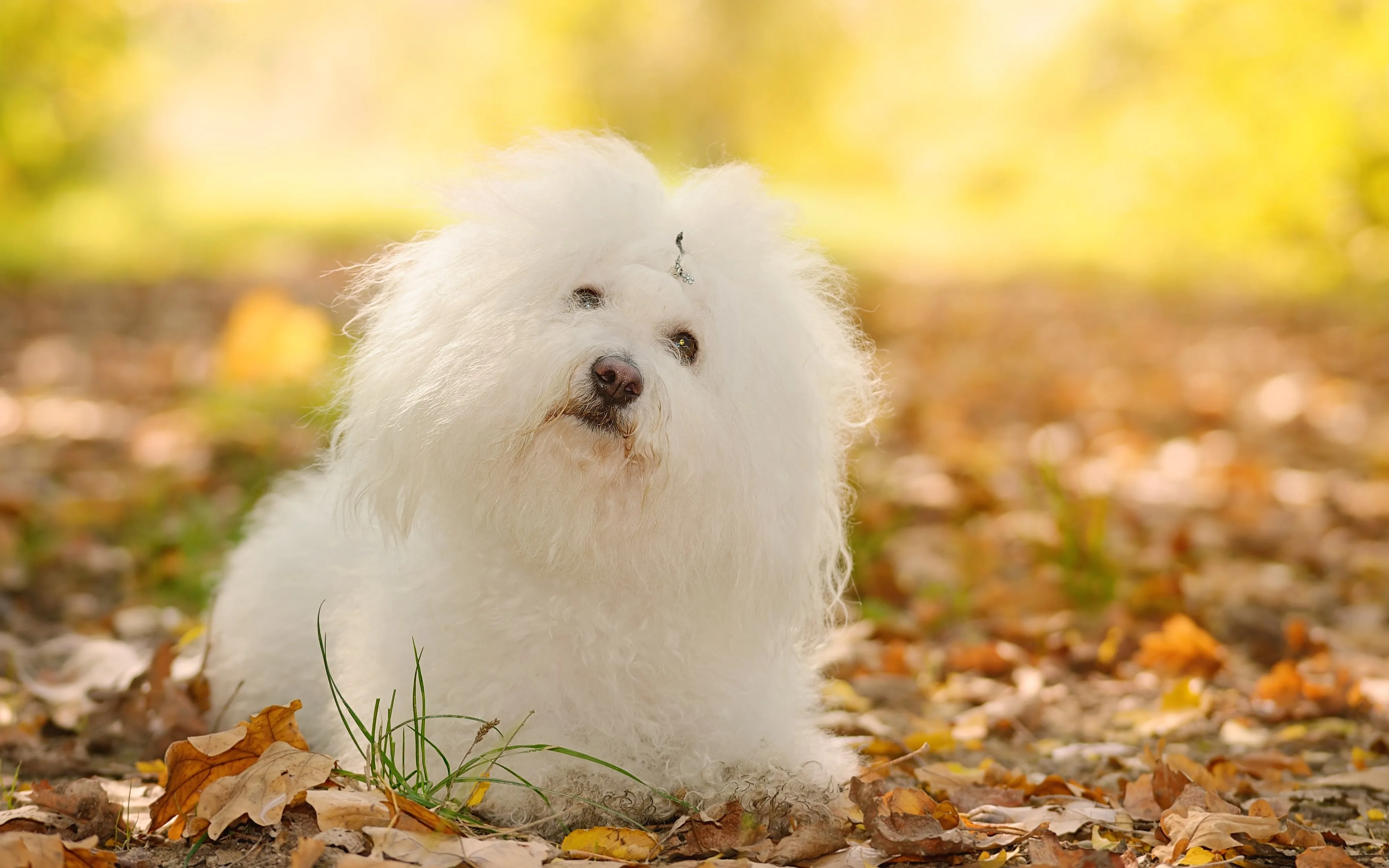 A white Bolognese dog, a playful and easygoing non-shedding breed, sits in an autumn forest.
A white Bolognese dog, a playful and easygoing non-shedding breed, sits in an autumn forest.
Originating in Italy, the Bolognese is an adorable small breed with a long, fluffy white coat that, despite its characteristic messy appearance, sheds minimally. These playful and easygoing pups are known for getting along well with children and other pets, and they can comfortably fit into various living situations. Their distinctive coat requires dedicated grooming to prevent matting and keep them looking their best.
17. Maltese
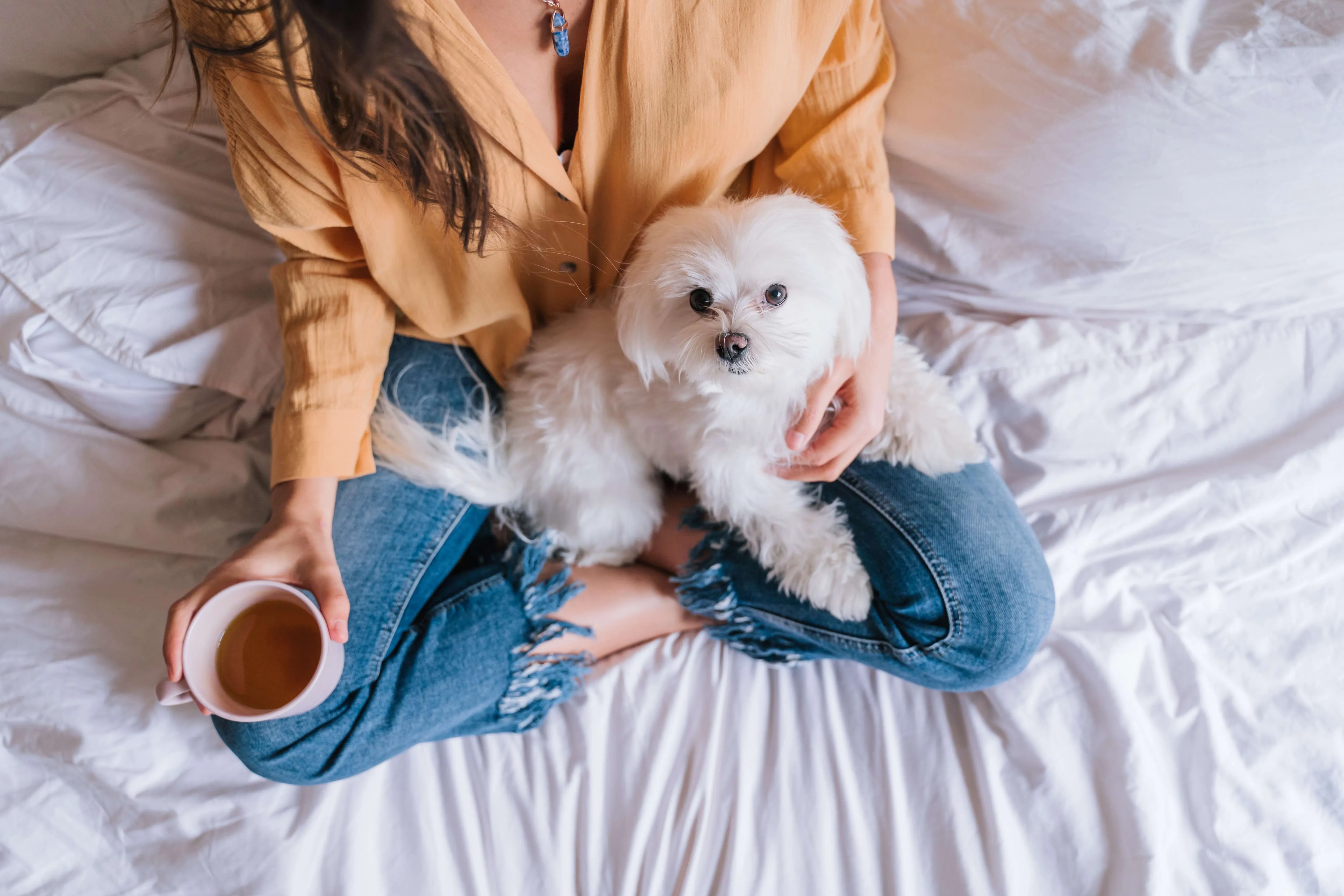 A woman holds a white Maltese dog, a small and affectionate type of dog who doesn't shed, on a bed.
A woman holds a white Maltese dog, a small and affectionate type of dog who doesn't shed, on a bed.
The Maltese is another charming small dog widely recognized for its luxurious, silky white coat. This breed is highly valued by allergy sufferers because they shed very little, making them an ideal small type of dogs that don’t shed. Maltese dogs are affectionate and playful companions, thriving on close human interaction. While their long coat is beautiful, it demands significant grooming. Many owners opt for a shorter “puppy cut” to simplify daily care, often using dog hair grooming clippers for convenience.
18. Soft Coated Wheaten Terrier
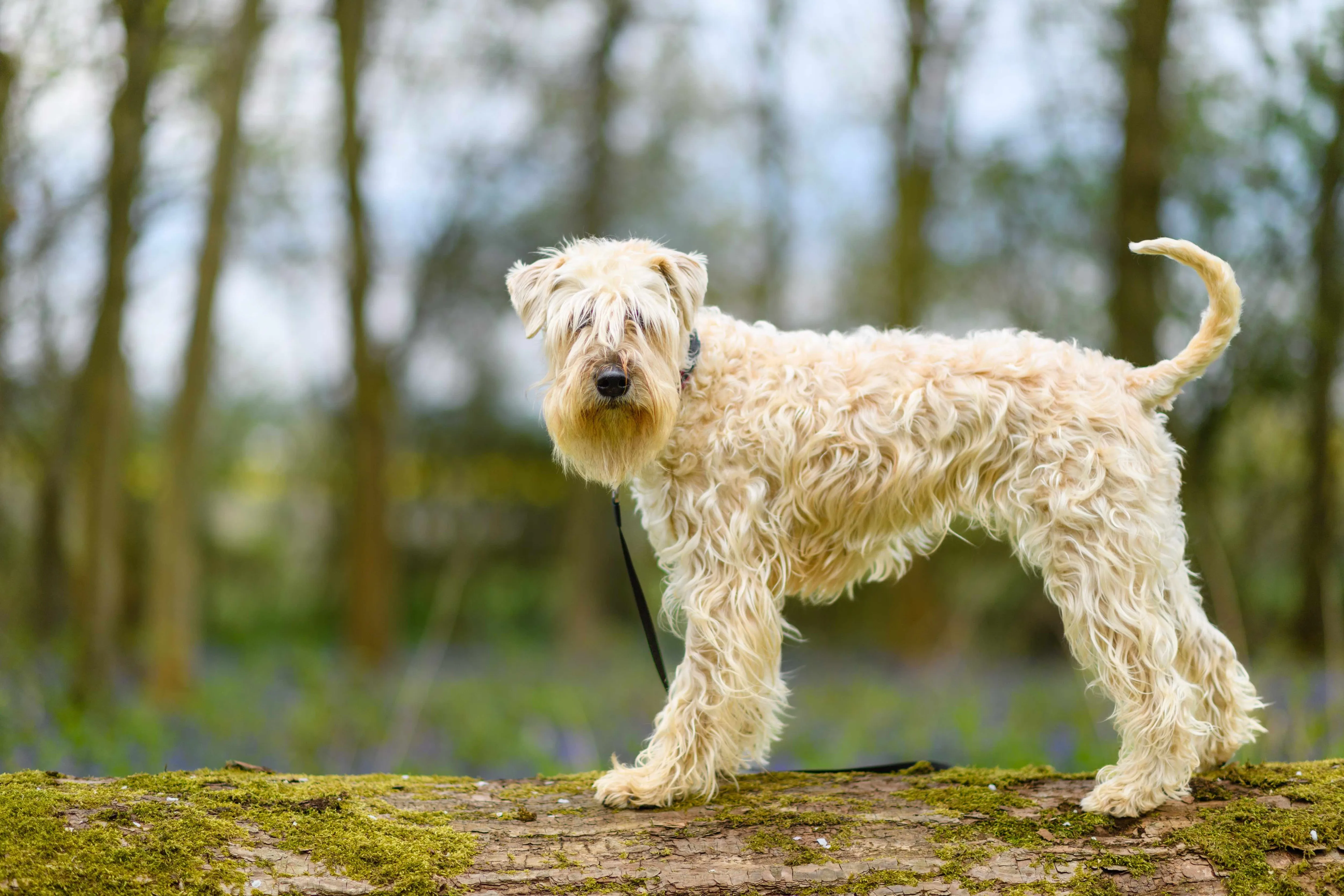 A Soft Coated Wheaten Terrier dog, a medium-sized Irish breed with a low-shedding coat, sits on a log.
A Soft Coated Wheaten Terrier dog, a medium-sized Irish breed with a low-shedding coat, sits on a log.
As its name suggests, the Soft Coated Wheaten Terrier is a medium-sized Irish breed distinguished by its incredibly soft, silky coat that sheds minimally. These terriers maintain a high energy level throughout their lives and require ample exercise and mental stimulation to prevent boredom and ensure good behavior. Their joyful and friendly demeanor makes them excellent family pets, provided their needs for activity are met.
19. Coton de Tulear
 A white Coton de Tulear, a small, easygoing hypoallergenic breed, sits in grass with its hair blowing in the wind.
A white Coton de Tulear, a small, easygoing hypoallergenic breed, sits in grass with its hair blowing in the wind.
The Coton de Tulear, a small breed originating from Madagascar, is known for its cotton-like coat that sheds very little. These easygoing pups possess a cheerful and gentle nature, making them a great fit for families with children and other pets, especially when proper introductions are facilitated. Their charming personality and minimal shedding qualities make them a popular choice among different types of small dogs that don’t shed.
20. Schnoodle
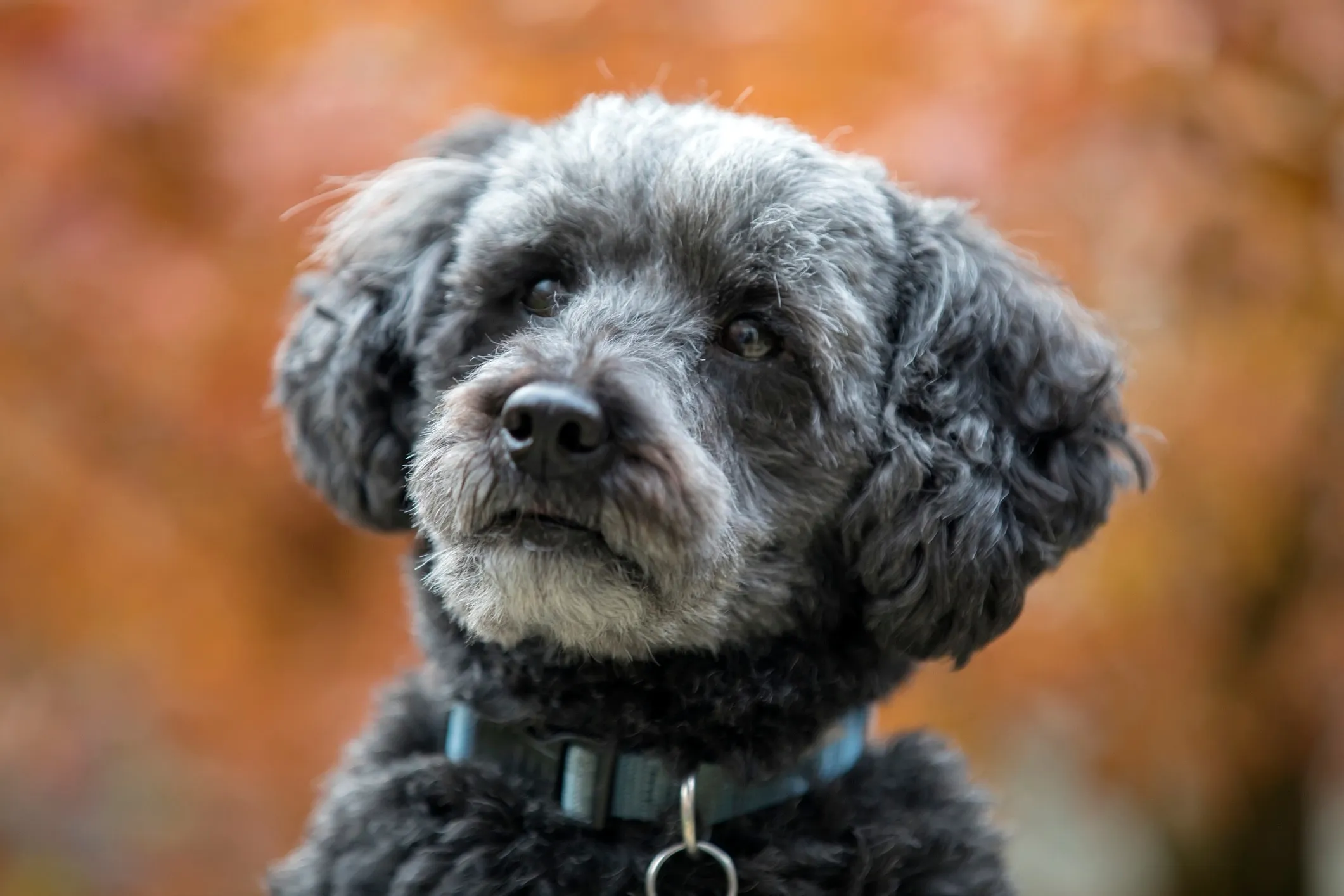 A gray Schnoodle, a low-shedding cross between two hypoallergenic breeds, shown in a close-up.
A gray Schnoodle, a low-shedding cross between two hypoallergenic breeds, shown in a close-up.
Unlike many “doodle” breeds that mix a Poodle with a shedding dog, the Schnoodle uniquely combines two hypoallergenic breeds: the Schnauzer and the Poodle. This makes them a particularly reliable choice among types of dogs who don’t shed. Their coat can be curly or wavy, depending on which parent’s genetics are more dominant, but it consistently remains low-shedding. Schnoodles are intelligent, playful, and adapt well to various lifestyles.
21. Bedlington Terrier
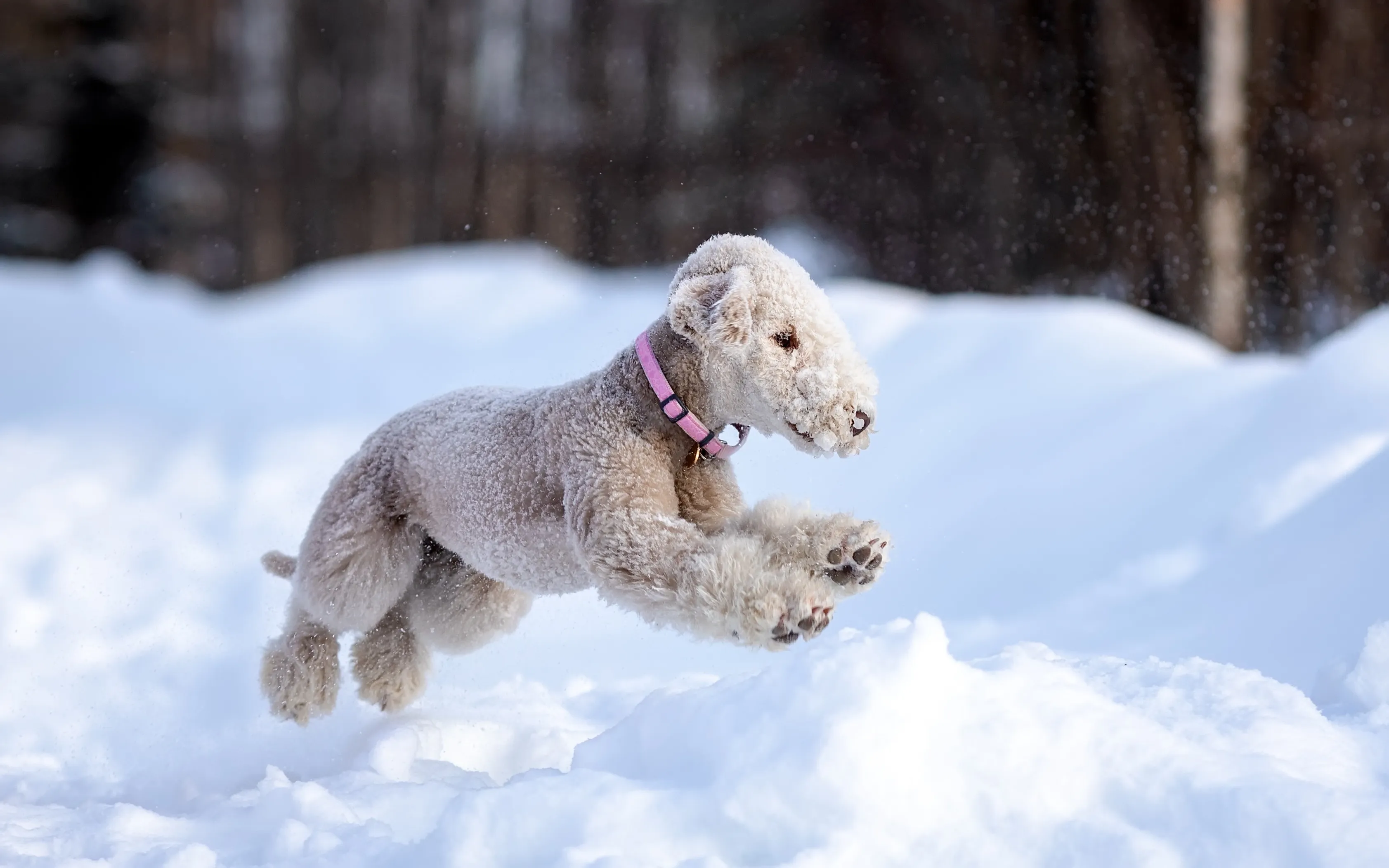 A white Bedlington Terrier, often described as a "lamb in dog's clothing," runs through snow.
A white Bedlington Terrier, often described as a "lamb in dog's clothing," runs through snow.
Often described as “a lamb in dog’s clothing” due to their distinctive woolly coat and elegant appearance, the Bedlington Terrier is a small, curly-haired breed that sheds very little. They are known for their unique topknot hairdo and pom-pom ear tufts. Bedlington Terriers are deeply devoted to their families and can develop separation anxiety if left alone for extended periods. Monitoring their activity with a dog camera can help manage and address such behavioral challenges.
22. Xoloitzcuintli (Mexican Hairless Dog)
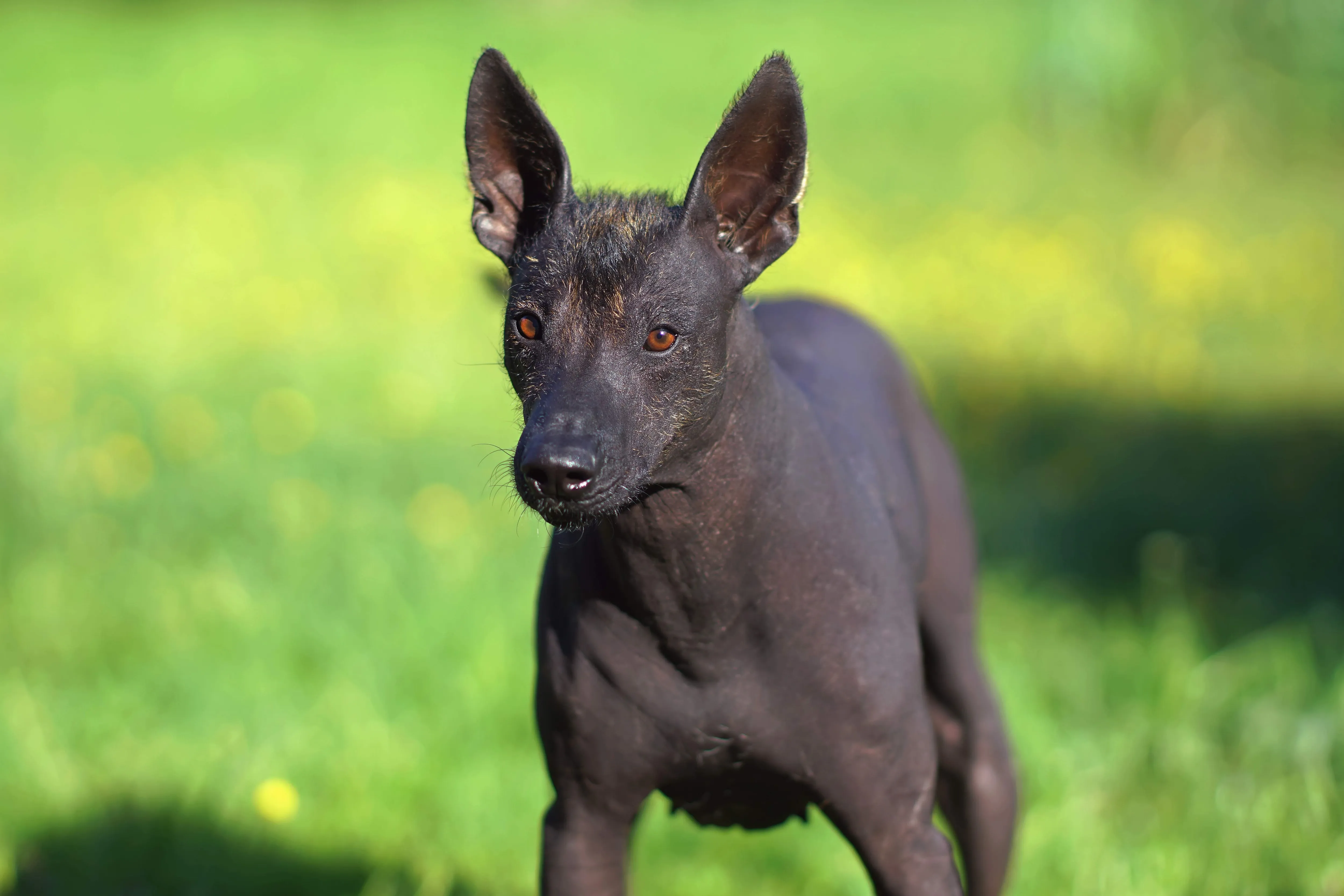 A black Mexican Hairless Dog (Xoloitzcuintli), an ancient hairless type of dog that doesn't shed, stands in grass.
A black Mexican Hairless Dog (Xoloitzcuintli), an ancient hairless type of dog that doesn't shed, stands in grass.
The Xoloitzcuintli, or Mexican Hairless Dog, is one of the oldest and rarest dog breeds in the world. This ancient breed comes in three sizes (toy, miniature, and standard) and two coat varieties: hairless and coated (with a very short, fine coat). Both varieties are considered hypoallergenic, making them an excellent choice for allergy sufferers. Xolos are known for their calm, alert, and loyal personalities, often forming strong bonds with their families.
23. Whoodle
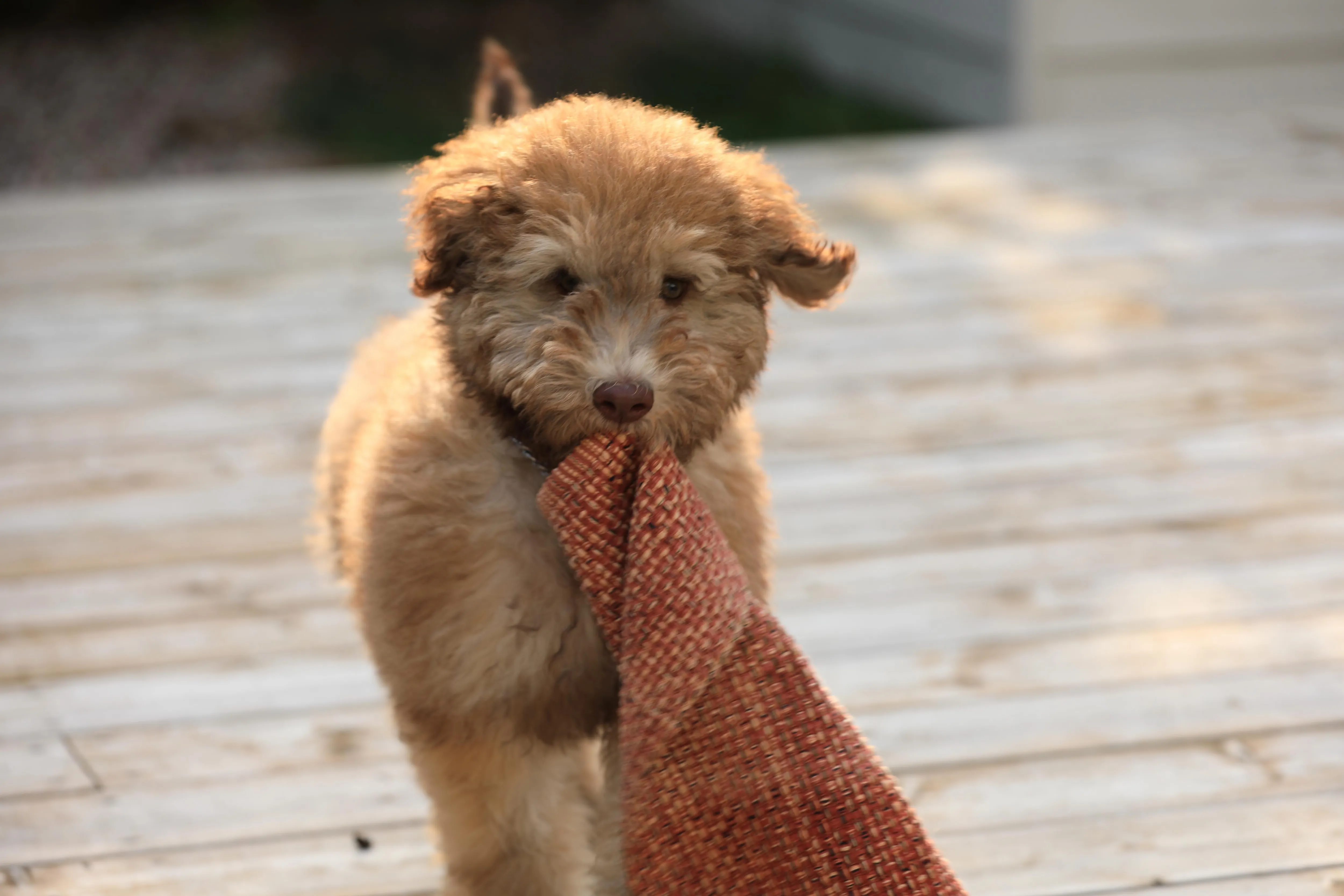 A tan Whoodle puppy, a friendly low-shedding dog, drags a washcloth playfully.
A tan Whoodle puppy, a friendly low-shedding dog, drags a washcloth playfully.
When a Soft-Coated Wheaten Terrier is crossed with a Poodle, the result is the Whoodle: a friendly, affectionate, and intelligent dog that sheds very little. Whoodles inherit desirable traits from both parent breeds, including a playful nature and a keen intellect. Their low-shedding coat makes them a fantastic option for families dealing with allergies, providing all the joy of dog ownership with reduced allergen exposure.
24. Bernedoodle
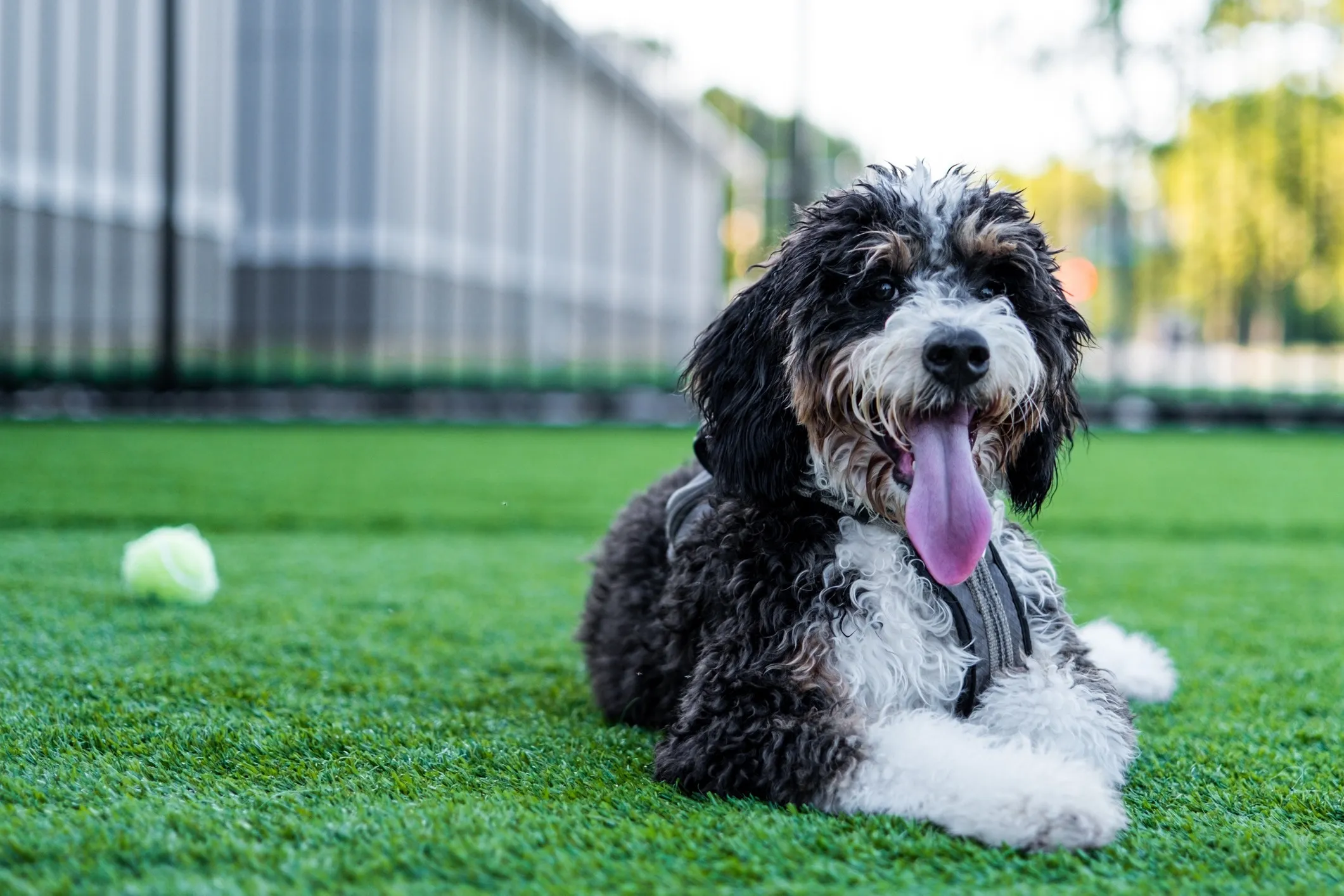 A large Bernedoodle dog, a friendly and gentle low-shedding crossbreed, lies in the grass with its tongue out.
A large Bernedoodle dog, a friendly and gentle low-shedding crossbreed, lies in the grass with its tongue out.
Bernedoodles are a charming crossbreed between the Bernese Mountain Dog and the Poodle. Known for their friendly, affectionate nature and gentle demeanor, these large low-shedding dogs are a popular choice for families, especially those with children and other pets. While their coats are typically low-shedding, they do require consistent grooming. Bernedoodles are energetic and need plenty of exercise to stay happy and healthy.
25. Shorkie
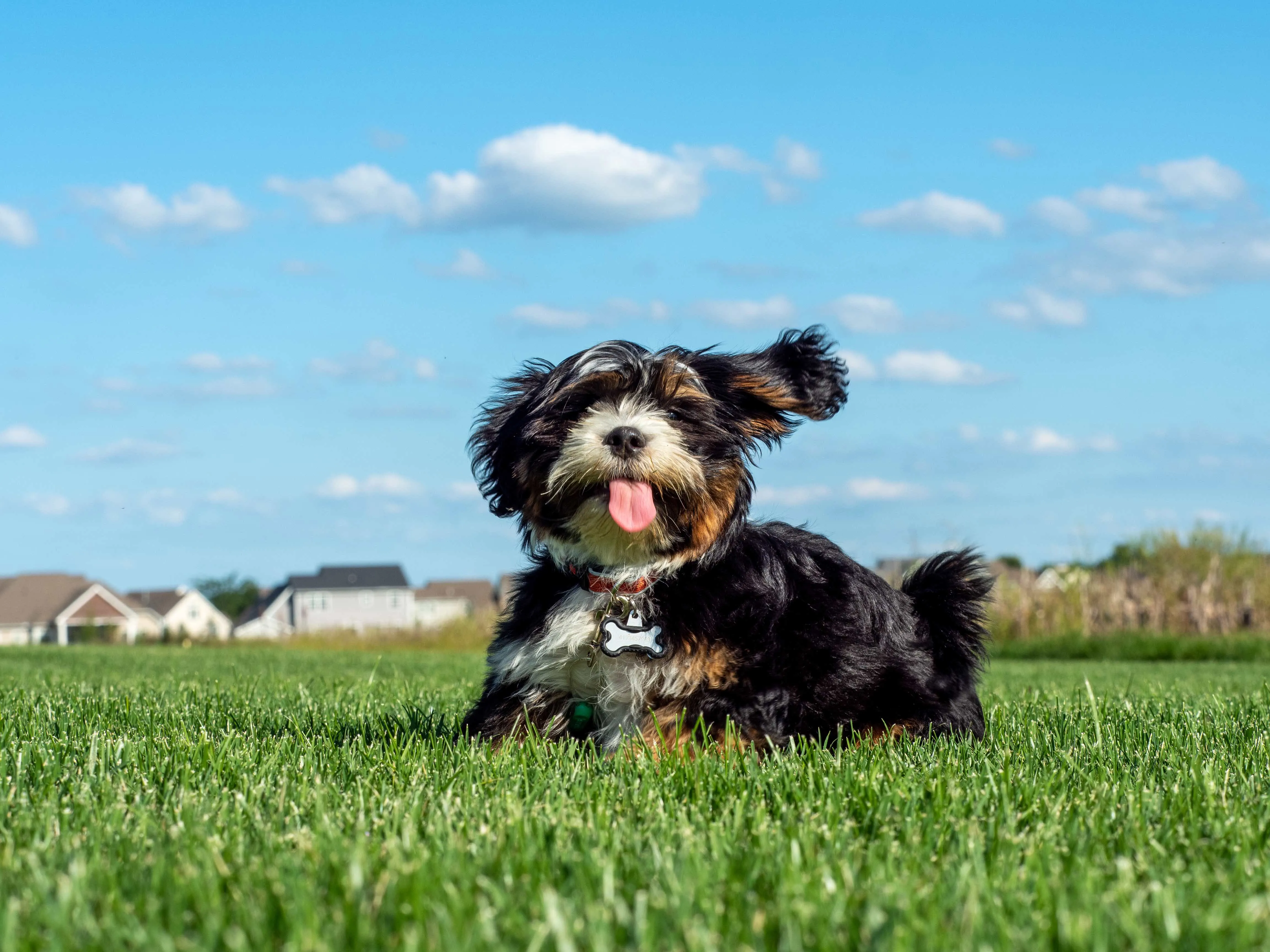 A tricolor Malshi dog, a happy small low-shedding companion, in green grass.
A tricolor Malshi dog, a happy small low-shedding companion, in green grass.
The Shorkie is a delightful mixed breed combining two already low-shedding dogs: the Shih Tzu and the Yorkshire Terrier. This pairing creates a small, playful, and friendly companion that embodies the best qualities of both breeds. Shorkies are highly affectionate and thrive on close companionship, making them ideal lap dogs. Like most dogs with complex coats, they require a dedicated and regular grooming routine to prevent matting and keep their fur in good condition.
26. Afghan Hound
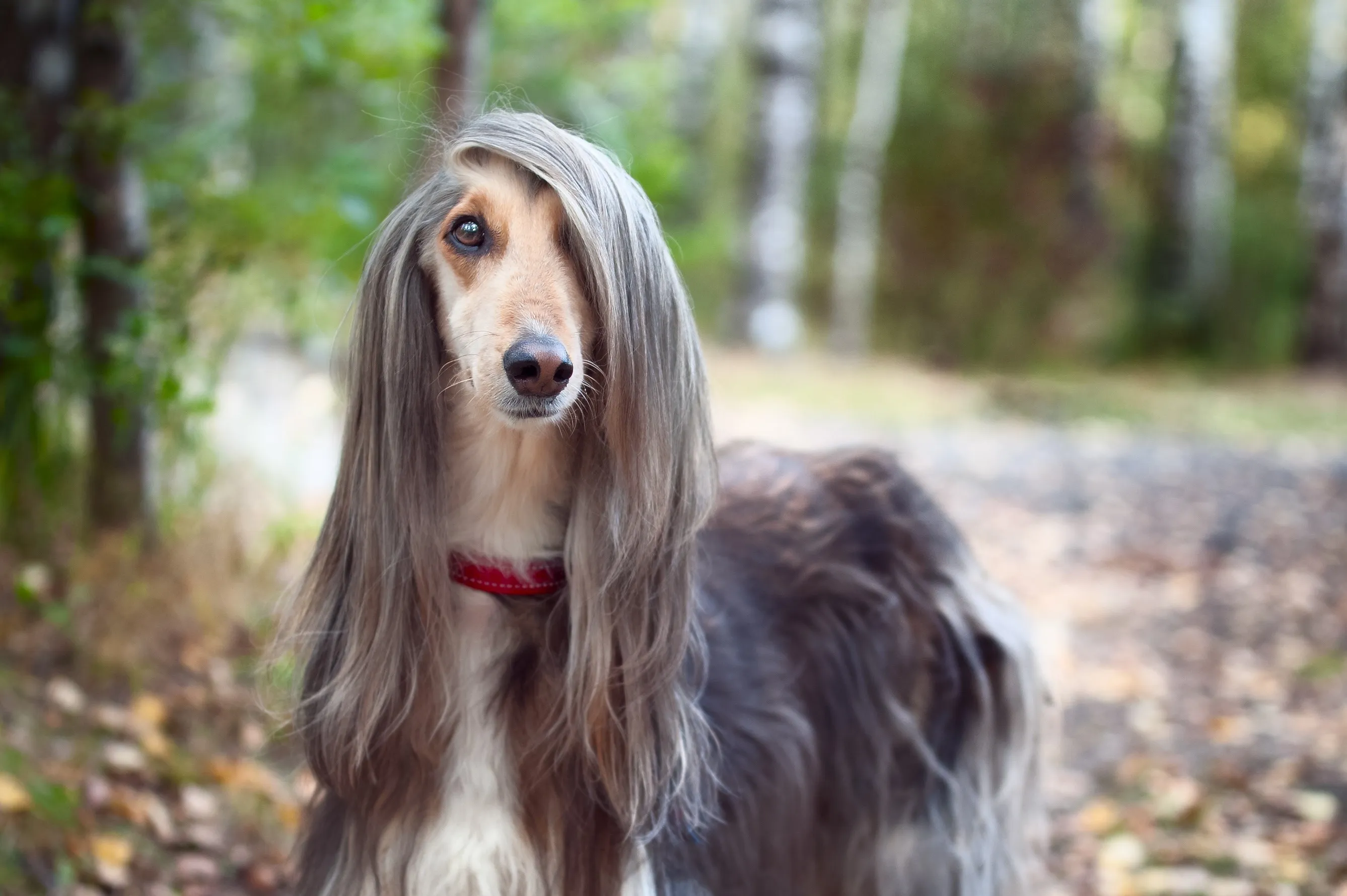 A gray and tan Afghan Hound, known for its long, flowing coat and minimal shedding, looks at the camera.
A gray and tan Afghan Hound, known for its long, flowing coat and minimal shedding, looks at the camera.
Afghan Hounds are instantly recognizable by their aristocratic appearance, featuring long, flowing coats and slender builds. Despite their voluminous hair, they are considered low-shedding. These elegant dogs are built for speed and possess a loving nature towards their families. However, they can be aloof with strangers, highlighting the importance of early and consistent socialization. Their magnificent coats require extensive and regular grooming to prevent tangles and mats.
27. Barbet
 A close-up of a curly red Barbet dog face, highlighting its shaggy, woolly, low-shedding coat.
A close-up of a curly red Barbet dog face, highlighting its shaggy, woolly, low-shedding coat.
The Barbet, pronounced “bar-bay,” is a cheerful pup with a shaggy, woolly coat that is low-shedding. The breed’s name comes from the French word “barbe,” meaning beard, a nod to its characteristically hairy chin. These big low-shedding dogs love to swim, a trait enhanced by their protective curly coats. To maintain the health and appearance of their coat, especially after water activities, regular brushing with a slicker or pin brush two to three times a week is crucial.
28. Shih-Poo
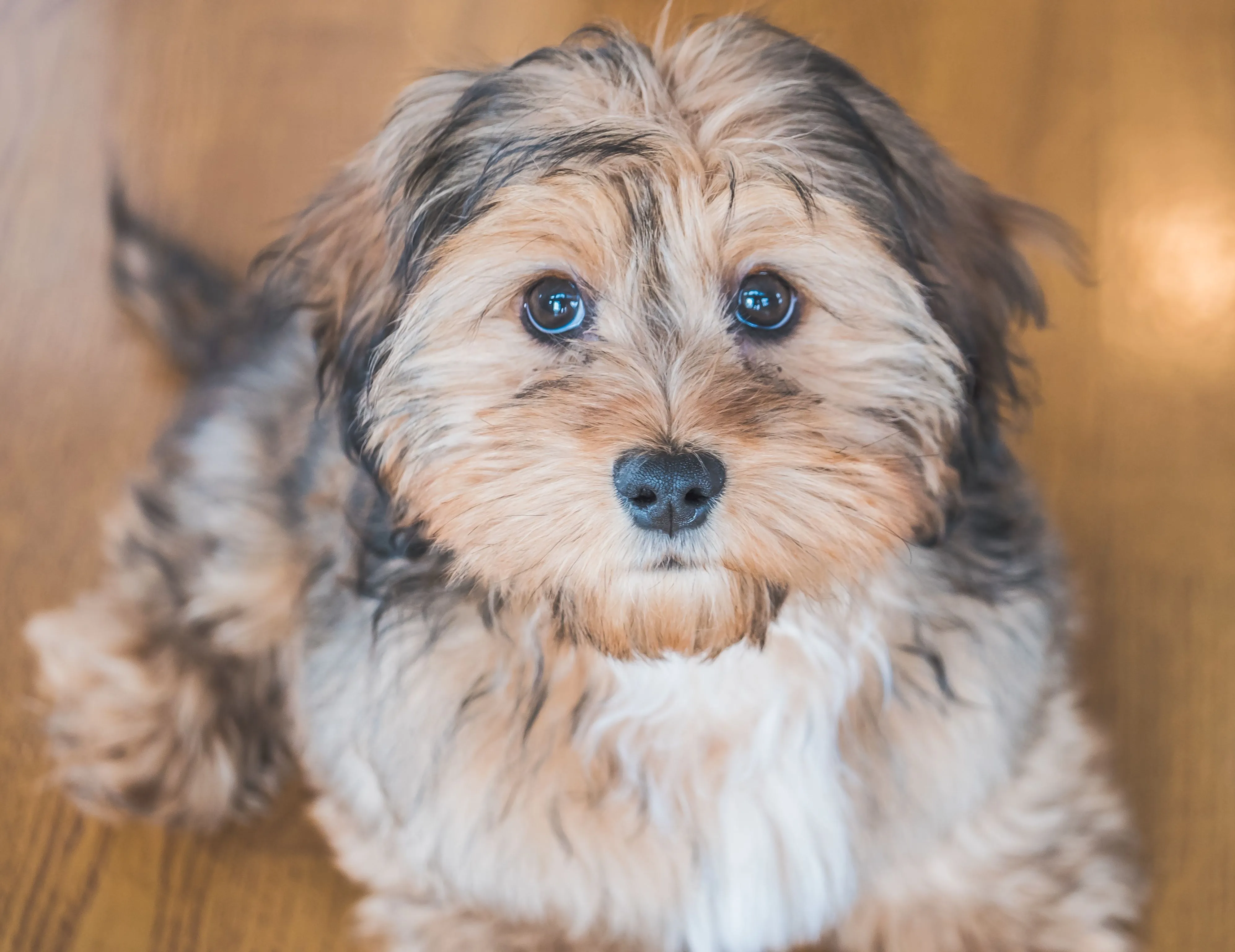 A tan and black Shih-Poo dog, a small, adaptable low-shedding mixed breed, in a close-up.
A tan and black Shih-Poo dog, a small, adaptable low-shedding mixed breed, in a close-up.
The Shih-Poo is a mixed breed resulting from a cross between a Shih Tzu and a Poodle, most commonly a Toy Poodle. This small, adaptable pup is known for its low-shedding coat and ability to thrive in almost any living situation, provided it receives around 30 minutes of daily exercise and a consistent brushing session. Shih-Poos are affectionate and playful, making them charming companions for a variety of households.
29. Peruvian Inca Orchid
 A Peruvian Inca Orchid dog, a rare ancient breed that is a type of dog who doesn't shed.
A Peruvian Inca Orchid dog, a rare ancient breed that is a type of dog who doesn't shed.
Though quite rare, the Peruvian Inca Orchid is an ancient dog breed recognized for its nearly hairless body, which inherently makes it hypoallergenic. This breed comes in three sizes (small, medium, and large) and is the national dog of Peru. Peruvian Inca Orchids are known for being noble, affectionate, and protective of their families, while also being somewhat wary of strangers. Their unique hairless quality places them firmly in the category of type of dogs that don’t shed.
30. Malshi
 A tricolor Malshi dog, a happy small low-shedding companion, in green grass.
A tricolor Malshi dog, a happy small low-shedding companion, in green grass.
The Malshi is a happy, small, low-shedding dog, created by crossing the Maltese and Shih Tzu breeds. These delightful companions thrive on close interaction with their favorite humans and require significant companionship to be truly content. Their friendly and outgoing personalities, combined with their minimal shedding, make them a wonderful choice for individuals and families seeking a charming, affectionate, and allergy-friendly pet.
Essential Tips for Living with a Low-Shedding Dog
Even when you choose from types of dogs who don’t shed much, it’s vital to implement certain practices to minimize allergens and ensure a comfortable environment for everyone. These tips go beyond breed selection to offer a comprehensive approach to managing allergies.
Consistent Grooming is Key
While low-shedding breeds release fewer hairs into the environment, their coats still require diligent care. Regular grooming is paramount to managing dander and keeping their skin healthy.
- Brushing: Most low-shedding breeds, especially those with curly or long coats, need daily or at least weekly brushing. This helps remove loose hair and dander before it can disperse, prevents matting, and stimulates healthy skin.
- Bathing: Regular bathing, typically every four to six weeks, is crucial. Using a specialized dog shampoo designed to reduce dander, such as Allerpet® Dog Dander Remover, can be highly effective.
- Professional Grooming/Trimming: Many low-shedding breeds require regular trimming or hand-stripping by a professional groomer to maintain their coat health and structure. Factor this into your budget or learn proper at-home grooming techniques.
- Dental Care: Good oral hygiene reduces saliva allergens. Regular teeth brushing and professional dental cleanings are important for your dog’s overall health and your allergy management.
Maintaining a Clean Home Environment
Minimizing allergens in your home is just as important as grooming your dog. Even the best type of dogs that don’t shed will still contribute to household allergens.
- Vacuuming and Dusting: Regularly vacuum floors, carpets, and upholstery with a HEPA-filter vacuum. Dust surfaces frequently with a damp cloth to trap allergens.
- Washing Bedding: Wash your bedding and your dog’s bedding weekly in hot water to remove dander.
- Air Purification: Utilize high-efficiency particulate air (HEPA) filters in your vacuum cleaner and home air purification systems to capture airborne allergens.
- Designated Dog Zones: Consider limiting your dog’s access to certain areas, such as bedrooms, to create an allergen-free zone for sleeping.
- Ventilation: Keep your home well-ventilated by opening windows when possible or using exhaust fans.
Consulting Your Doctor and Veterinarian
Managing pet allergies effectively often requires professional guidance.
- Talk to Your Healthcare Provider: If you have allergies, consult with your doctor or an allergist. They can confirm your allergies, provide an allergy management plan, and recommend appropriate treatments, which may include antihistamines, nasal sprays, or allergy injections.
- Consult Your Veterinarian: Discuss your allergy concerns with your vet. They can provide advice on your dog’s diet, skin health, and grooming needs, all of which contribute to dander production. They can also rule out other skin conditions that might exacerbate shedding.
- Avoid Direct Contact with Saliva/Urine: Remember that allergens are also present in saliva and urine. Try to avoid letting your dog lick your face, and clean up any accidents promptly and thoroughly.
Bringing a low-shedding dog into your life can be a truly rewarding experience, offering the joy of pet companionship even with allergies. By selecting a suitable breed and diligently implementing these care and cleaning strategies, you can create a happy, healthy, and largely sneeze-free home for both you and your beloved canine friend. Want to know more about the best breeds for your lifestyle? Explore our comprehensive guide on specific dog breed that doesn’t shed much for deeper insights.
